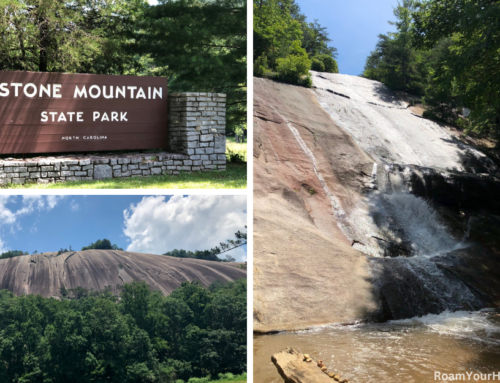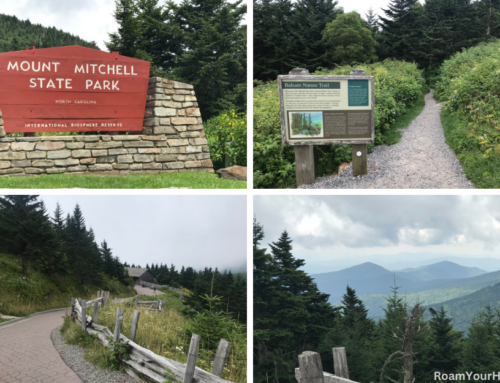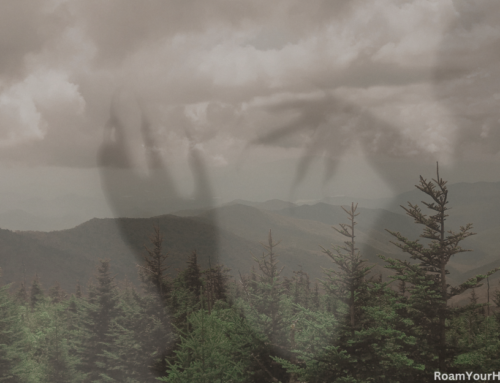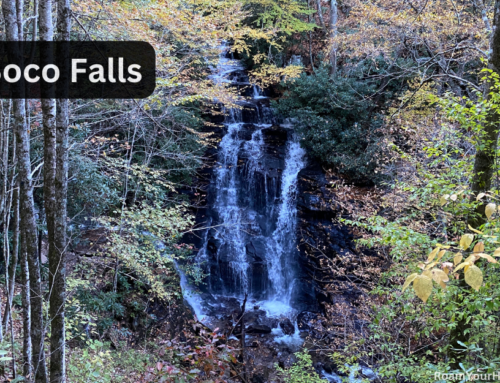
Wright Brothers National Memorial: Exploring Aviation History
The Wright Brothers National Memorial is in the windswept dunes of Kill Devil Hills, North Carolina. It is a tribute to Orville and Wilbur Wright, the pioneers of flight.
The park is where the brothers forever changed the course of history, making their groundbreaking first power flight on December 17, 1903.
What to See and Do at Wright Brothers National Memorial
We visited on a beautiful mid-week summer afternoon. There were only thin, wispy clouds in the sky; thankfully, it was not too hot. We were on a road trip down the coast and very excited to visit the memorial. We were familiar with the Wright Brothers from school and had previously visited the Dayton Aviation Heritage National Historical Park in Ohio.
When we arrived about an hour after they opened, the large parking lot was about halfway full. We walked straight to the nearby visitor center to make a game plan for our visit.

Visitor Center
To my wife’s and my delight, the visitor center was packed with fascinating exhibits showcasing the Wright brothers’ early experiments, struggles, and ultimate triumph. A full-scale reproduction of the 1903 Wright Flyer was particularly impressive. The original is displayed at the National Air and Space Museum in Washington DC. We spent about 30 minutes checking out the visitor center, picking a magnet for a souvenir, and speaking with a super friendly park ranger about what to make sure not to miss during our visit.
“The desire to fly is an idea handed down to us by our ancestors who… looked enviously on the birds soaring freely through space… on the infinite highway of the air.”
– Wilbur Wright

Replica of the Wright Brothers’ Camp
Our first stop right after leaving the visitor center was a reconstructed Wright brothers’ camp building. These were open and gave us a glimpse into their daily lives in 1903. We could see a humble wooden hangar and living quarters, both built at the location where Wilber and Orville lived while experimenting.
The Flight Line & First Flight Markers
Next up was the exact spot where the Wright brothers made history. The flight line is marked with stone monuments indicating the distances of their test flights. We started at the First Flight Boulder, which marks the lift-off point for the four successful flights on that December Day. Each flight would get progressively longer and is marked along a walking path.
At 10:35 AM, the Wright Flyer lifted off for the first time, lasting 12 seconds and 120 feet. In the picture above, you can see Orville at the controls with Wilbur running alongside. Many consider this one of the most iconic photographs ever taken.
The brothers took turns flying that day, each getting a feel for the controls and increasing their distance with each flight. The second flight was 12 seconds and 175 feet, and the third was 15 seconds and 200 feet. Wilbur’s last flight, the fourth and last of the day – was an astonishing 852 feet in 59 seconds.
This would be the last time the Wright Flyer took the sky. It would not fly again; after Wilbur’s final flight, it was caught by a gust of wind, flipped over, and broken beyond simple repair. Their flying season was over, and the Wright brothers sent their family a matter-of-fact telegram reporting their success.
Walking along these markers offered an incredible perspective and a tangible connection to the Wright Brother’s remarkable achievement.
“The airplane stays up because it doesn’t have the time to fall.”
– Orville Wright
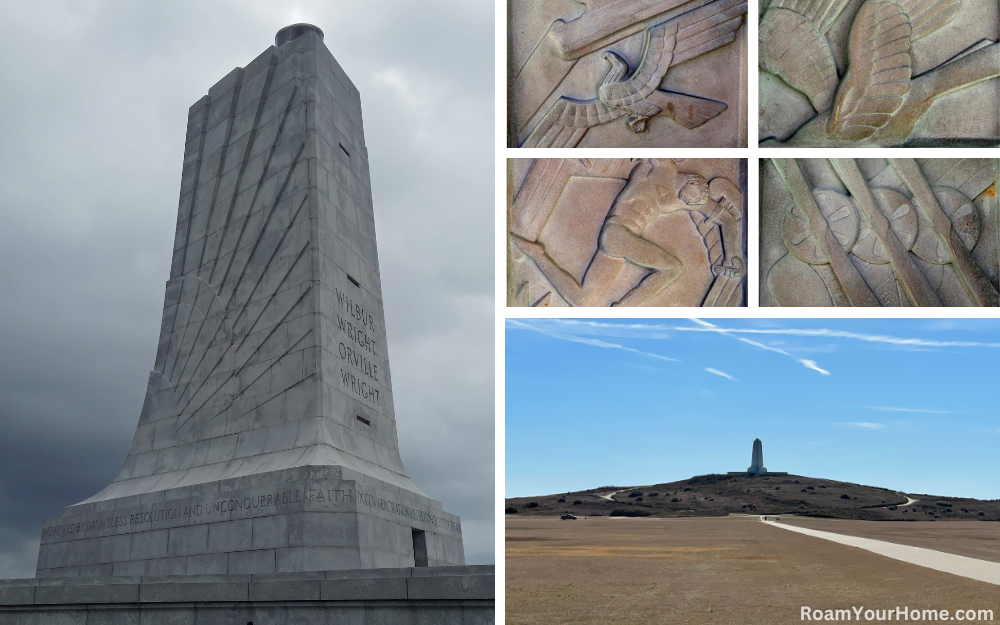
Wright Brothers Monument
Next, we walked a path towards the Wright Brothers Monument, which is perched atop Big Kill Devil Hill. The towering 60-foot granite monument overlooks the site. This was the hill where the brothers conducted glider experiments before their powered flight. A short but rewarding walk up the hill offers terrific panoramic views of the surrounding Outer Banks.
An inscription on the monument reads, “In commemoration of the conquest of the air by the brothers Wilbur and Orville Wright. Conceived by genius. Achieved by dauntless resolution and unconquerable faith.”
The December 17, 1903, Sculpture is near the Wright Brothers Monument on the south side of Kill Devil Hill. The bronze and steel sculpture reenacts the historic first flight. Orville pilots the machine, Wilbur runs alongside, and the witnesses who assisted with the flights that day look on and cheer. The park service calls this a “please-touch sculpture.” You can climb up, lay next to the Orivile in the plane, and stand next to Wilbur and the crowd.
If you do not feel like walking from the First Flight Markers to the monument and sculpture, there is a road, and parking is available.
Our trip to the Wright Brothers National Memorial left a lasting impression. Standing on the ground where humans first took to the skies was a thought-provoking and humbling experience that I cannot recommend enough.
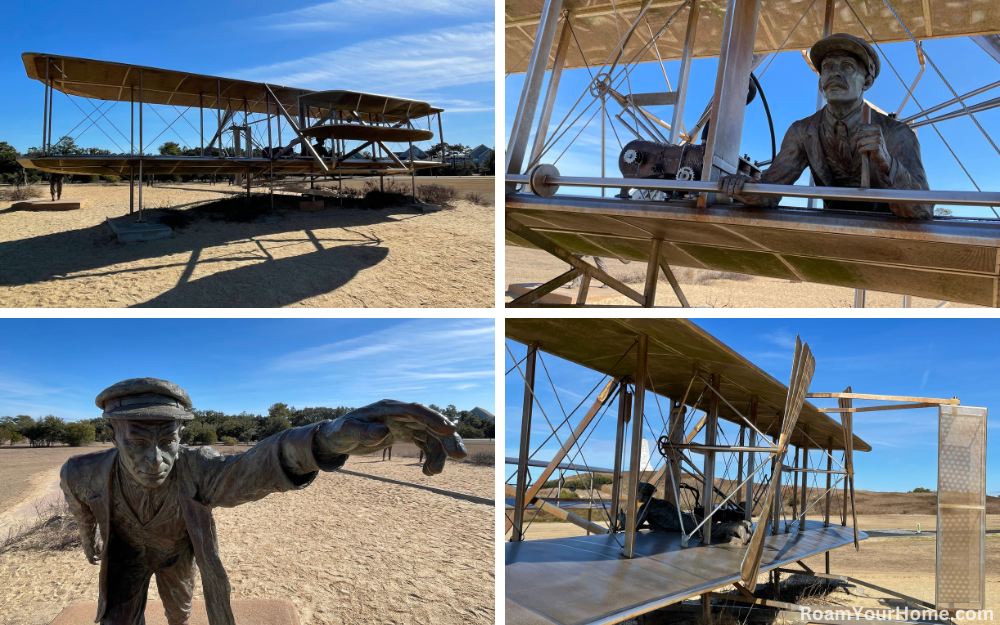
How to get There
It’s located on North Carolina’s Outer Banks and is easily accessible via U.S. Highway 158. If you’re flying in, the nearest airport is Norfolk International Airport, which is 82 miles or about an hour and a half drive away. A scenic coastal drive leads you to Kill Devil Hills, where the monument proudly stands. The Raleigh-Durham International Airport is about a three and half hour drive east.
Things to do Nearby
There are many things to do near the Wright Brothers National Memorial along the Outer Banks.
On our trip, we also stopped at Jockey’s Ridge State Park, home to the tallest natural sand dunes on the East Coast.
We explored Fort Raleigh National Historic Site, Roanoke Island, and the mysterious Lost English Colony.
Cape Hatteras National Seashore is a stunning stretch of beaches and iconic lighthouses. We were absolutely dumped on by rain camping here for two days, but it was still pretty.
Travel Tips
Best Time to Visit: Spring and fall offer mild temperatures and fewer crowds. Summer is warm but busy. When we left during our summer visit, the parking lot was completely full.
There is a small entry fee.
What to Bring: Comfortable walking shoes, sunscreen, and a camera to capture the historic landscape.

